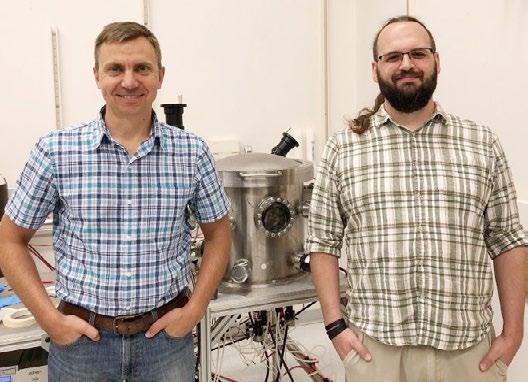
3 minute read
U Physicists Find Technique that Offers Improved Resolution and Characterization of Perovskite-based Photovoltaics
Andrey Rogachev, left, and Kevin Davenport Researchers have developed a method for directly measuring the electronic transport at interfaces within a perovskite-based solar cell

Advertisement
The work of Associate Professor Andrey Rogachev and Associate Instructor Kevin Davenport was recently featured in the June 26, 2020, issue of Applied Physics Letters, a weekly peer-reviewed scientific journal published by the American Institute of Physics. Its focus is rapid publication and dissemination of new experimental and theoretical papers regarding applications of physics in all disciplines of science, engineering, and modern technology.
By Alane Lim
Perovskite-based solar cells are promising alternatives to traditional silicon cells. However, the current research only offers a limited understanding of these complex devices, since the electron transport within the device is physically difficult to probe.
Davenport et al. have adapted a spectroscopic method to capture a “big picture” look at the carrier dynamics within a perovskite-based solar cell. Using cross-correlation current noise spectroscopy, the team measured signals that they could localize to specific locations, including the absorption layer, the transport layer, and the interfaces in between, inside the device.
For the study, the authors used a modified form of noise spectroscopy, a method that characterizes the movements of electrons via the fluctuations or noise in an electrical signal. Using this technique, the team measured their device’s current to find signals, such as those coming from electrons at the device’s interfaces that would normally have been drowned out by much stronger ones. The technique also exhibited spatial selectivity: the resistance measured in one region correlated to the strength of the signal coming from that region. As such, the team could determine the origins of their signals.
Overall, the technique allows researchers to directly and nondestructively probe electron movements throughout a perovskite cell, including its interfaces.
Coauthor Kevin Davenport said the method can complement more traditional techniques, such as impedance spectroscopy, to obtain a more complete understanding of the physical processes occurring within solar cells.
“In a world where we are competing for fractions of a percent in increased efficiency, any additional information is critical,” Davenport said.
Davenport added the authors plan to continue their work in several ways, including testing different perovskites and improving the resolution and range of their technique.
Source: “An analysis of carrier dynamics in methylammonium lead triiodide perovskite solar cells using crosscorrelation noise spectroscopy,” by Kevin Davenport, Fei Zhang, Mark Hayward, Logan Joseph Draper, Kai Zhu, and Andrey Rogachev, Applied Physics Letters (2020). The article can be accessed at https://doi.org/10.1063/5.0010260.
Published by AIP Publishing (https:// publishing.aip.org/authors/rights-andpermissions). Largest 3D Map of the Universe Ever Created
Continued from page 3
aspects of the analysis. To create the part of the map dating back six billion years, the team used large, red galaxies. Farther out, they used younger, blue galaxies. Finally, to map the universe eleven billion years in the past and more, they used quasars, which are bright galaxies lit up by material falling onto a central supermassive black hole. Each of these samples required careful analysis in order to remove noise and reveal the patterns of the universe.
“The SDSS data allow unique insights into the evolutionary history of our universe” says Dawson. “Using these data, along with data from the Cosmic Microwave Background and supernovae, we have made the largest advances of any experiment in the last decade to determine the intrinsic curvature of space. We have explored the energy contents of the universe, the laws of gravity, and the physics of some of the smallest particles, the neutrinos, and now have a model for these components that allows us to estimate the local expansion rate to 1% precision.”
eBOSS, and SDSS more generally, leaves the puzzle of dark energy, and the mismatch of local and early universe expansion rates, as a legacy to future projects. In the next decade, future surveys may resolve the conundrum, or, perhaps, will reveal more surprises.
Meanwhile, the SDSS is nowhere near done with its mission to understand the universe. Gail Zasowski, the spokesperson for the next generation of SDSS, described her excitement for the next steps.
“We’re upgrading the hardware and instruments needed to keep the tremendous impact of SDSS going into the 2020s,” Zasowski says. “We’ll be focusing on the history of our own Milky Way Galaxy, the architecture of multi-star and planetary systems, how galaxies make their stars, and how black holes grow over the lifetime of the universe. These are some of the most exciting questions in astrophysics, and we’re looking forward to the next decades of discovery!”

